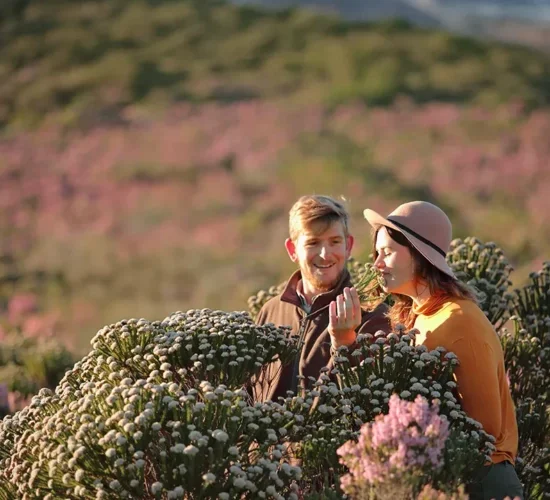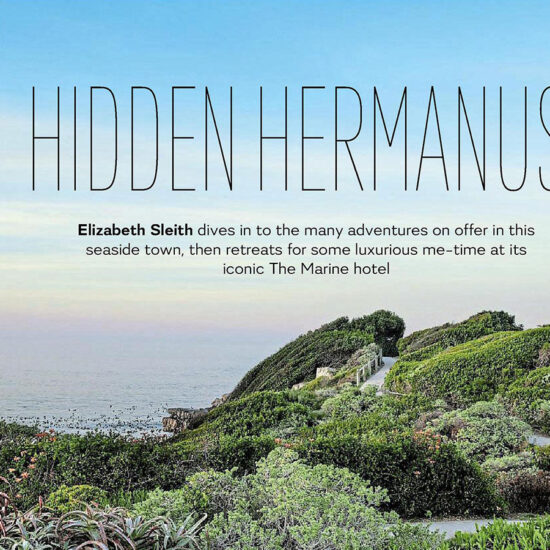Whale Coast – Did you know?
per person
- Visitors can approach the Cape Whale Coast by following Clarence Drive to Rooiels, Hangklip, Pringle Bay, Betty’s Bay and Kleinmond. Clarence Drive has been voted the most scenic route in the world.
- Betty’s Bay is the home of a unique colony of African Penguins. These penguins have made their home at the old Waaygat Whaling Station at Stony Point which was used to harvest and process whale meat in the early to mid-1900s. The whaling station closed in 1930.
- Kogelberg Biosphere was South Africa’s first registered biosphere and stretches from Gordon’s Bay to the Bot River Vlei at Kleinmond and covers 18000 hectares. It is also accredited as a UNESCO World Heritage Site, one of eight UNESCO heritage sites in South Africa.
- The Bot River Vlei at Kleinmond is the Western Cape’s second-largest blind estuary, meaning it is not permanently connected directly to the ocean.
- A herd of wild horses roams from Rooisands, Kleinmond, to Fisherhaven.
- Arabella Hotel and Spa in Kleinmond’s golf course itself is an 18-hole masterpiece, a Par 72 championship course. Among this golf estate awards is the 18th hole, voted the best finishing hole in South Africa.
HERMANUS
- Because of Southern Right whales visiting the Walker Bay coastline of the Cape Whale Coast Hermanus has the world’s only Whale Crier. Newly appointed Ricardo Andrews has taken over as the 6th Whale Crier.
- Hermanus must be the only place with a station but never had a train service. The station was built in the hope that a holidaying Head of SA Railway Services, Sir William Hoy, would link Hermanus with Bot River with railway tracks to make Hermanus more accessible.
- Fernkloof Nature Reserve covers 1800 hectares of fynbos – a tenth of the size of the Kogelberg Biosphere.
- Fernkloof Nature Reserve has more than 1400 species of fynbos and 60 kilometres of hiking trails.
- The Cape Whale Coast has three internationally awarded Blue Flag beaches: Kleinmond, Hawston and Grotto Beach. Awarded for its world class amenities, safety and pristine environment.
- Hermanus is one of only three places in South Africa with a 27-hole golf course.
- Hemel-en-Aarde wine region neighbours Hermanus and is home to South Africa’s best Pinot Noir.
- Hermanus Wine Route has 12 wineries with tasting facilities generally open to the public.
- Hermanus has two harbours.
- Hermanus host an annual Passion Play during Easter which attracts hundreds of people to view the performance of the crucifixion in the Old Harbour.
- Hermanus host an annual Whale Festival.
- The Southern Right whales visit the Walker Bay area from July to November each year.
STANFORD
- Stanford has the shortest river in the world from source to mouth – only 5km as the crow flies. The Klein River meanders along for 80km as it takes its own route.
- The Klein River Estuary is 10 km long, and 2 km wide, and is known as the Kleinriviersvlei
- Stanford was proclaimed a heritage village including the Market Square in 1997
- Many of the survivors of the Birkenhead ship wreck recuperated at De Klein Valey House in Stanford, after coming ashore at what is known as Stanford’s Cove which is 20km away in de Kelders.
- Stanford has a unique leiwater system which channels water from a spring called ‘Die Oog to
- Stanford properties by gravity. People use this water to water their gardens and vegetables.
- Stanford celebrated 150 years in 2007
- Stanford Wine Route launched in 2015
- Stanford has a cheese named after it, made at Klein River Cheese Farm
- Almost 200 bird species can be found in and around Stanford
- As Stanford stands on the banks of a wetland, it is also home to many frogs included the protected Western Leopard Toad.
GANSBAAI
- Gansbaai is the Great White Shark Capital of the world due to the size and consistency of the great white shark population off the Gansbaai coast.
- Platbos, just outside Gansbaai has the southernmost forest in Africa
- Gansbaai Colf Course – 9-hole is the southernmost golf course in Africa and has a sea view.
- Gansbaai has been voted Overall Winner Responsible Tourism Destination in Africa in 2015.
- Gansbaai is home to the Marine Big Five – sharks, whales, penguins, dolphins and seals.
- Gansbaai is the Great White Shark Capital of the world due to the size and consistency of the great white shark population off the Gansbaai coast.
- Gansbaai Golf Club is the southernmost golf course and it has a sea view. 9-holes.
- Gansbaai won Best Destination for Responsible Tourism in the World (WTM London 2015)
- Danger Point Lighthouse established in 1892 – after the Birkenhead sank in 1852 – the need for a lighthouse on the coast was re-enforced. Also a monument to the Birkenhead at the Lighthouse.
- HMS Birkenhead sank in 1852 – Although the saying – “Women and children first” was not originated at that time – it was issued by Captain Salmon and has become the norm since then in maritime situations. (436 men died and all the women and children were saved!)
- Gansbaai’s Dyer Island Cruises received Blue Flag status
- Gansbaai is home to the African and Seabird Sanctuary
HANGKLIP-KLEINMOND
- Kleinmond falls under the Kogelberg Biosphere Reserve.
- The Kleinmond Lagoon and beach is a popular spot for holiday-makers to lounge on the beach, play in the shallow waters and canoe down the lagoon.
- Next to the Lagoon, you can find the famous Preekboom which served as a meeting point for churches in the early 1900s.
- On the Hermanus side of Kleinmond, you’ll find the Rooisand Nature Reserve where wild horses roam free.
- Kleinmond holds 2 golf courses – one located at the foot of the Kogelberg Mountains and the other at Arabella Hotel & Spa.
- The infamous whaling station at Stony Point was established in 1913.
- Betty’s Bay was named after Arthur Youldon’s daughter.
- The main road running through Betty’s Bay and beyond was named after Jack Clarence.
- Stony Point in Betty’s Bay is home to one of the only two shore-based African Penguin colonies in South Africa.
- The town plays host to its very own Belgian Master Chocolatier at Gaboli Chocolates.
- The villages of Pringle Bay and Rooi Els were founded in the 1930s when 3 business men, namely Harold Porter, Arthur Youldon and Jack Clarence, bought the land.
- Both the villages fall under the Kogelberg Nature Reserve.
- The nearby Hangklip Lighthouse, which can be accessed via a walking trail along the coastline was built in 1960.
- The village of Pringle Bay was named after the Royal Naval Commander-in-Chief, Sir Thomas Pringle.
- It is famous for its rocky shores and the cave, “Drostersgat”, which was used by prisoners and runaway slaves as a hide-away in the 18th century.
Facts on Wildlife & Flowers:
- Cape Leopard has been sighted. The Cape Clawless Otter may be seen in or near the Palmiet River. Smaller antelope include grey rhebuck, klipspringer and grysbok, while baboons, porcupine, mongoose, dassies and hares are fairly common. Peregrine
- Falcons, black eagles and fish eagles hunt and nest in the area. An endemic fresh water crab is also found. Look out for the endangered Oystercatcher.
- Baboon troops occur in the Overstrand area at Rooi Els, Pringle Bay, Betty’s Bay, Kleinmond and Hermanus. Even though our natural fynbos environment provides ample nutritious food, baboons are smart opportunists who find human food irresistible.
- The Cape fynbos is one of the wonders of the world. Although it is the smallest of the world’s six plant kingdoms by far, it is second because of its great diversity with 9000 different species in 90 000 square kilometers. 6190 of these species are exclusive to Cape Flora. To help put these figures in perspective: the British Isles is three and a half times larger, but only has 1500 species of which only 20 are endemic! It was the early Dutch settlers who described the hardy plants of the Cape as “fijnbosch”, meaning “fine-leafed bushes”. Today the term “fynbos” refers to all diverse types of plants, proteas, ericas, restios grasses and geophytes (including gladioli, lilies and orchids) that survive on the nutrient-poor soils, high winds and dry summers that characterise the southern tip of Africa. The two main habitats of fynbos are mountains and lowlands (coast) and within these types are categories such as heathy fynbos, proteoid fynbos, rietveld (reed-like) and asteraceous (daisy family) fynbos.
- IncludedWhale Coast – Did you know?
- Not IncludedNatureRelaxationHobbyEnthusiastsFamily-fun




